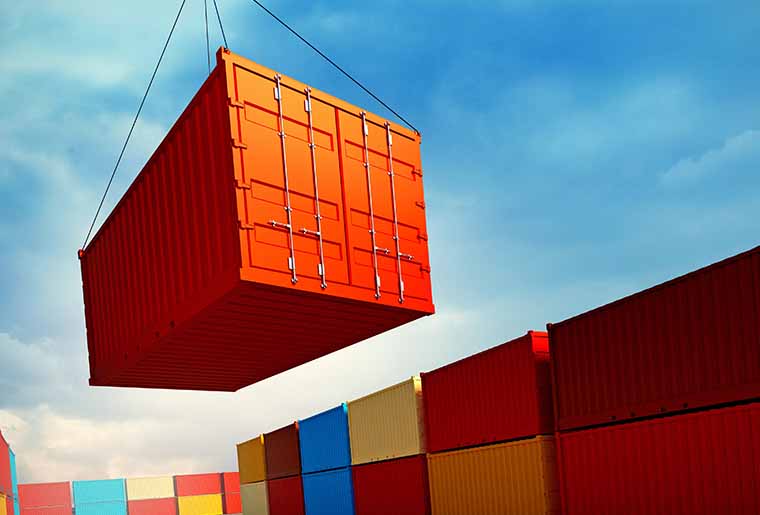Do you need to ship your goods by sea? If so, it’s a good idea to learn more about shipping containers. We explain them below, discussing the dimensions of a sea container, how they are used, the different types available, and their advantages
What are shipping containers?
Shipping containers are standardized metal structures used to transport goods by sea and land. Their standard sizes are 20 or 40 feet, which facilitates loading and unloading from ships and trucks. These containers are robust, airtight, and stackable, ensuring the safety and efficiency of transporting all types of products, from food products to manufactured goods. Shipping containers have revolutionized the transport industry, enabling fast and efficient handling of cargo worldwide and playing a fundamental role in the globalization of trade.
Uses of shipping containers beyond logistics
Shipping containers are versatile and can be used for many purposes. They are widely used for global freight transport, allowing the shipment of all types of products, from raw materials to manufactured goods. In addition to their primary function in transport, containers are reused in various ways:
For building homes or storage spaces.
They can also be converted into mobile office modules, pop-up stores, or even creative spaces for art and culture.
In short, their durability and ease of handling have led to a wide range of adaptive uses, making them key elements in the global economy and architectural innovation.
How are shipping containers used
Shipping containers are loaded with various products at factories and warehouses, and then shipped by sea, train, or truck through an intermodal network. These standardized containers facilitate efficient loading and unloading, reducing costs and time. In addition, they are used for storing goods in ports or cargo areas.
Types of Shipping Containers
There are several types of shipping containers designed to transport specific types of goods and to meet different logistical needs. The most common types are detailed in this section:
- Dry Van Container: This is the standard container, used for most dry cargo, such as manufactured goods, canned food, and clothing. They are airtight and protect against the elements.
- Reefer Container: Designed for perishable goods, such as food and pharmaceuticals. They maintain controlled temperatures and have refrigeration systems.
- Flat Rack Container: These have no fixed side walls or roof, making them ideal for oversized cargo, heavy machinery, and large structures.
- Open Top Container: Similar to the Dry Van, but with a removable roof to facilitate loading of bulky goods or those requiring cranes.
- Tank Container: Used for transporting liquids, such as chemicals or bulk food products, and have specialized linings.
- Cistern Container: Designed to transport bulk liquids, such as oil and chemicals.
These different types of containers allow for the efficient and safe shipment of a wide range of products, adapting to the specific cargo and logistics needs of global maritime transport.
Dimensions of Shipping Containers: The Key to Standardization
One of the major revolutions in freight transport was the standardization of the dimensions of a sea container. Thanks to this, global logistics became simpler, allowing the same container to be handled by cranes, trucks, and trains in any corner of the world.
20-foot Container (20′ Dry Van)
The 20-foot container is the most compact and versatile size. It is ideal for cargo that, while not extremely large in volume, can be heavy. Its external dimensions are:
- Length: 6.058 meters (20 feet)
- Width: 2.438 meters (8 feet)
- Height: 2.591 meters (8.5 feet)
- Load capacity: Its maximum weight capacity is approximately 28 tons, while its usable internal volume is around 33 cubic meters.
This type of container is widely used for dry goods, such as bags of coffee, machinery parts, cement, and other building materials. Its size makes it easy to handle, and it is an economical option for small or medium-sized shipments.
40-foot Container (40′ Dry Van)
The 40-foot container is the most commonly used container worldwide for sea transport. Its dimensions are double those of the 20-foot container, making it ideal for large-volume cargo. Its external dimensions are:
- Length: 12.192 meters (40 feet)
- Width: 2.438 meters (8 feet)
- Height: 2.591 meters (8.5 feet)
- Load capacity: Although its volumetric capacity is around 67 cubic meters, its maximum weight capacity is similar to that of a 20-foot container, around 28 tons. This is due to the weight limitations of ships and trucks. Therefore, it is the perfect option for bulky but lightweight cargo, such as clothing, furniture, or electronic products.
40-foot High Cube Container (40′ High Cube)
The High Cube is a variant of the 40-foot container that offers extra height, significantly increasing its volumetric capacity. It is a very popular option for maximizing space when transporting lightweight goods. Its external dimensions are:
- Length: 12.192 meters (40 feet)
- Width: 2.438 meters (8 feet)
- Height: 2.896 meters (9.5 feet)
- Loading capacity: It increases the usable volume to approximately 76 cubic meters, making it ideal for bulky or stacked goods, such as toys, plastic products, or large packages.
45-foot Containers (45′ Dry Van)
Although less common in pure sea freight, 45-foot containers are widely used in intermodal transport within Europe and North America. They provide even greater capacity and are an efficient option for optimizing cargo on land routes. Among the dimensions of a sea container, their external measurements are:
- Length: 13.716 meters (45 feet)
- Width: 2.438 meters (8 feet)
- Height: 2.896 meters (9.5 feet)
- Loading capacity: They offer a volume capacity of up to 85 cubic meters, making them the ideal solution for very large loads that benefit from the extra space.
Benefits of Shipping Containers for Freight Transport
Shipping containers offer a number of significant benefits in transport and logistics:
- Efficiency: They facilitate fast loading and unloading, reducing handling times and speeding up transport.
- Security: They protect goods from damage, theft, and adverse weather conditions.
- Standardization: Their dimensions are uniform, which simplifies logistics planning and the use of multiple modes of transport.
- Intermodality: They can be transported by ship, train, truck, or even plane, optimizing the global supply chain. Cost reduction: They save money on packaging, handling, and storage.
- Sustainability: They contribute to waste reduction, as they are reusable and recyclable.
- Adaptability: They can be transformed into habitable or commercial structures, promoting reuse.
- Globalization of trade: They connect economies worldwide, boosting international trade.
- Flexibility: There are specific types for various types of cargo, such as liquids, perishable goods, or oversized loads.




